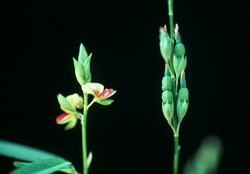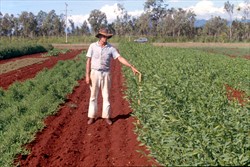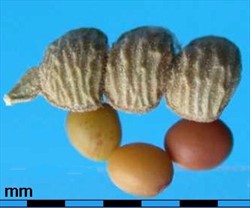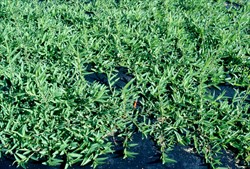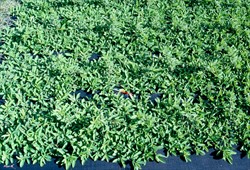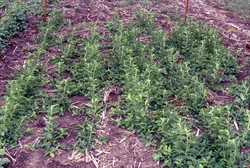Alysicarpus rugosus
Tropical Forages
Alysicarpus rugosus (Willd.) DC.
Subordinate taxa:
Alysicarpus rugosus (Willd.) DC. subsp. perennirufus J. Léonard
Alysicarpus rugosus (Willd.) DC. subsp. reticulatus Verdc.
Alysicarpus rugosus (Willd.) DC. subsp. rugosus
var. rugosus: Basionym: Hedysarum rugosum Willd.
Family: Fabaceae (alt. Leguminosae) subfamily: Faboideae tribe: Desmodieae subtribe: Desmodiinae.
Erect, prostrate or ascending annual or perennial herb or subshrub to 60 (150) cm. Stem glabrous or pilose. Leaves stipulate, mostly unifoliolate (simple), rarely trifoliolate, to 1.5‒7.5 (‒10) cm long and 0.2‒2 (‒2.5) cm broad, usually oblong, rarely orbicular or linear-lanceolate, obtuse, apiculate, glabrous above, appressed hairy below, obtuse to broadly rounded or subcordate at the base; stipules scarious, almost encircling the stem, 6‒11 mm long; petiole c. 3‒6 (‒20) mm long. Inflorescence simple or branched, dense raceme, 4‒10 (‒25) cm long. Flowers with keel and wings red to pinkish purple, standard often paler to orange, 6‒7 mm long; bracts 5‒8 mm long, chaffy; pedicel 3‒4 mm long; calyx 6‒9 mm long, deeply divided, teeth lanceolate, imbricate, minutely ciliate. Pods 5‒10 (‒12) mm long, 3‒5 (6) jointed; pod articles (loments) 1–1.5 (‒3) mm long and 1.5–3 mm wide, prominent, close, transverse ridges. Seeds reddish brown or olive in colour, compressed, 1.5 mm long. Morphological traits vary greatly within the species.
Africa: urukuka (Burundi); ngandu (DRC); kambé (Guinea); gadagi (Nigeria); mbãto, mbégu (Fula-Pulaar), bampto ngoro (Tukulor), dégavantiéna (Konyagi), sokuani (Manding-Bambara), mbamat (Serer), baamal bongor (Wolof) (Senegal)
Asia: 皱缩链荚豆 zhou suo lian jia dou (China); đậu vảy ốc nhám; bút quả nhám, bút quả (Vietnam)
English: false moneywort, red moneywort, rough chainpea
Indian subcontinent: sheora, shevra (India); madhu mool (Nepal)
Indian Ocean: fokolahy (Madagascar)
Native:
Africa: Angola; Benin; Botswana; Burundi; Central African Republic; Chad; Democratic Republic of Congo; Côte d'Ivoire; Eritrea; Ethiopia; Ghana; Guinea; Guinea-Bissau; Kenya; Mali; Mozambique; Niger; Nigeria; Rwanda; Senegal; Sierra Leone; South Africa (Eastern Cape, KwaZulu-Natal, Limpopo, Mpumalanga); Swaziland; Sudan; Tanzania; Togo; Uganda; Zambia; Zimbabwe
Western Indian Ocean: Madagascar
Asia: China (Yunnan); India; Nepal; Pakistan; Sri Lanka; Laos; Myanmar; Thailand; Vietnam; Indonesia; Malaysia
Australasia: Australia (Queensland, Western Australia, Northern Territory)
Naturalized:
Asia: Taiwan
Forage
Potential as an annual ley legume for cut and carry or grazing.
Environment
Green manure. Used as companion crop with sorghum and pearl millet in India. Tested as a ley legume for heavy textured soils in Queensland, Australia
Other
Seeds listed as famine food in India.
Soil requirements
Often found on dark, cracking clays, but also grows on lighter soils. Poorly adapted to acid-infertile soils.
Moisture
Grows in areas with (600‒) 900–1,500 mm annual rainfall.
Temperature
Warm season growth, but grown up to 1,400 m in the foothills of the Himalayas.
Light
Intolerant of low light conditions.
Reproductive development
Largely a short day plant, although flowering times vary with genotype. Seeds in first year of growth.
Defoliation
Poor persistence under grazing; poor regeneration from seed.
Fire
Unlikely to tolerate fire unless the plant has dropped seed, enabling regeneration from soil seed reserves.
Guidelines for establishment and management of sown forages.
Establishment
Generally planted in a species mixture at 0.25–0.5 kg/ha seed. Hard seed coat requires scarification. Early growth is generally rapid, but long-term persistence is generally poor for planted crops.
Fertilizer
Could be expected to respond to P, K and S on soils that are deficient or below the optimum pH range of 6–8.
Compatibility (with other species)
Poor compatability with aggressive weeds or grasses especially in drier environments. Common weed in freshly cultivated land.
Companion species
Generally sown in a mixture of herbaceous and twining legumes or as companion species in warm season grain crops.
Pests and diseases
No information available.
Ability to spread
Limited ability to spread under grazing because of high palatability and short-lived life cycle. Although good seed set may occur in the first year, hard-seededness prevents early recruitment from seed.
Weed potential
Recorded as a weed of wet season cropping in India (upland rice, mung beans and pigeon pea). Has become naturalized in Taiwan. Hard-seededness assists long-term spread.
Nutritive value
Crude protein concentrations range from 15 to 22% for leaf, and 8 to 10% for stem. Tends to become stemmy in mixed pastures. In Zambia, stem comprised 60% of total yield.
Palatability/acceptability
Palatable.
Toxicity
None reported.
Feedipedia link
Dry matter
In single species plots, annual DM yields of 3,000–7,500 kg/ha have been recorded in Zambia, Vanuatu and Australia. Annual yields decline progressively and substantially in the second and third years from sowing, most accessions failing to persist beyond the third year.
Animal production
There are few references to animal production potential in the literature. Green lucerne as a supply of 50% of crude protein requirements for crossbred dairy weaner cattle in India was replaced by A. rugosus hay without reduction in liveweight gains. Similar results were reported in related work where liveweight gains peaked with 40% replacement of crude protein requirements with A. rugosus hay.
No breeding programs have been undertaken. Substantial variation exists in morphology and ability to perennate. 2n = 16
Heavy seed production but harvest is difficult due to uneven ripening and break-up of seedpods when ripe.
Seedlings susceptible to 2,4-D, 2,4,5-T, MCPA and aminotriazole at concentrations of 500–1,000 ppm.
- Rapid establishment.
- Highly palatable.
- High quality.
- Short-lived and hard-seeded, resulting in poor persistence.
- Regeneration from seed is generally poor for planted crops.
Gramshaw, D., Pengelly, B.C., Muller, F.W., Harding, W.A.T. and Williams, R.J. (1987) Classification of a collection of the legume Alysicarpus using morphological and preliminary agronomic attributes. Australian Journal of Agricultural Research 38:355–372. doi.org/10.1071/AR9870355
Kallah, M.S., Bale, J.O., Abdullahi, U.S., Muhammad, I.R. and Lawal, R. (2000) Nutrient composition of native forbs of semi-arid and dry sub-humid savannas of Nigeria. Animal Feed Science and Technology 84:137–145. doi.org/10.1016/S0377-8401(99)00131-5
Njarui, D.M.G., Beattie, W.M, Jones, R.J. and Keating, B.A. (2004) Evaluation of forage legumes in the semi-arid region of eastern Kenya. I. Establishment, visual bulk rating, insects, pests and diseases incidences of a range of forage legumes. Tropical and Subtropical Agroecosystems 4:33–55.
Patkl, P.M., Gholap, G.U., Gujar, B.V. and Pawar, A.S. (1991) Effect of part protein replacement by leguminous weed shevra (Alysicarpus rugosus DC.) in the diet of crossbred (Holstein x Deoni) heifers. Indian Journal of Animal Nutrition 8:69–72. bit.ly/397I7H9
Peacock, A. and Smith, F.T. (1992) Evaluation of pasture legumes on a seasonally flooded heavy clay soil in south-east Queensland. Australian Plant Introduction Review 23:20–23.
None released.
CPI 51655 (IL67-1 India) Origin unknown. High yielding annual, ability to regenerate. Potential as a ley legume for clay soils in Queensland, Australia.
CPI 76978 (MM 128) Origin Mt Makulu Res. Stn, Zambia. Perennial to ca. 60 cm tall, dense foliage, persisted in humid tropics and subtropics (700–1,000 mm/year) in Queensland, Australia; excellent nitrogen fixer, well eaten by dairy cows.
CPI 94489 Origin near As(e)be Tefer(r)i (Chiro), Ethiopia (9°03' N, 40°52' E, 1,900 m asl). Weak perennial to ca. 60 cm tall, large seeds, established easily and grew rapidly, but regenerated only under favourable moisture conditions; excellent nitrogen fixer, well eaten by dairy cows.
CPI 52351 Origin Limbe, Malawi (15°50' S, 35°03' E, 1,100 m asl, 850 mm rainfall). Perennial, persisted in humid tropics and subtropics (700–1,000 mm/year) in Queensland, Australia. Established well and persisted with fair yields at sites in eastern Kenya (>1,000 m asl and 700–1,000 mm rainfall).
CPI 30187, CPI 69487, CPI 106418 Relatively large seeded annual types evaluated in Australia. They established easily and grew rapidly but regenerated only under favourable moisture conditions.
CPI 52349 (India); 52356, 52357 (Malawi); CPI 33149, 60167 (Uganda); 43748, 52350, 76977, 76979, 76980 (Zambia); 52346, 52347, 52348, 52367, 84470 (Zimbabwe): similar M-A grouping to CPI 52531 above.
